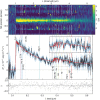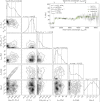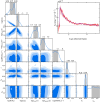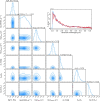A recently quenched galaxy 700 million years after the Big Bang
- PMID: 38447669
- PMCID: PMC11062910
- DOI: 10.1038/s41586-024-07227-0
A recently quenched galaxy 700 million years after the Big Bang
Abstract
Local and low-redshift (z < 3) galaxies are known to broadly follow a bimodal distribution: actively star-forming galaxies with relatively stable star-formation rates and passive systems. These two populations are connected by galaxies in relatively slow transition. By contrast, theory predicts that star formation was stochastic at early cosmic times and in low-mass systems1-4. These galaxies transitioned rapidly between starburst episodes and phases of suppressed star formation, potentially even causing temporary quiescence-so-called mini-quenching events5,6. However, the regime of star-formation burstiness is observationally highly unconstrained. Directly observing mini-quenched galaxies in the primordial Universe is therefore of utmost importance to constrain models of galaxy formation and transformation7,8. Early quenched galaxies have been identified out to redshift z < 5 (refs. 9-12) and these are all found to be massive (M⋆ > 1010 M⊙) and relatively old. Here we report a (mini-)quenched galaxy at z = 7.3, when the Universe was only 700 Myr old. The JWST/NIRSpec spectrum is very blue (U-V = 0.16 ± 0.03 mag) but exhibits a Balmer break and no nebular emission lines. The galaxy experienced a short starburst followed by rapid quenching; its stellar mass (4-6 × 108 M⊙) falls in a range that is sensitive to various feedback mechanisms, which can result in perhaps only temporary quenching.
© 2024. The Author(s).
Conflict of interest statement
The authors declare no competing interests.
Figures







References
-
- Endsley R, et al. A JWST/NIRCam study of key contributors to reionization: the star-forming and ionizing properties of UV-faint z ~ 7–8 galaxies. Mon. Not. R. Astron. Soc. 2023;524:2312–2330. doi: 10.1093/mnras/stad1919. - DOI
-
- Tacchella S, et al. JWST NIRCam + NIRSpec: interstellar medium and stellar populations of young galaxies with rising star formation and evolving gas reservoirs. Mon. Not. R. Astron. Soc. 2023;522:6236–6249. doi: 10.1093/mnras/stad1408. - DOI
-
- Mason CA, Trenti M, Treu T. The brightest galaxies at cosmic dawn. Mon. Not. R. Astron. Soc. 2023;521:497–503. doi: 10.1093/mnras/stad035. - DOI
-
- Whitler L, et al. Star formation histories of UV-luminous galaxies at z ≃ 6.8: implications for stellar mass assembly at early cosmic times. Mon. Not. R. Astron. Soc. 2023;519:5859–5881. doi: 10.1093/mnras/stad004. - DOI
-
- Endsley, R. et al. The star-forming and ionizing properties of dwarf z~6-9 galaxies in JADES: insights on bursty star formation and ionized bubble growth. Preprint at https://arxiv.org/abs/2306.05295 (2023).
Publication types
MeSH terms
LinkOut - more resources
Full Text Sources
Research Materials

